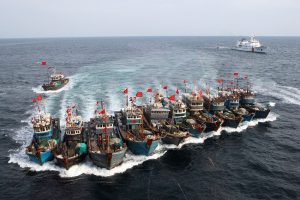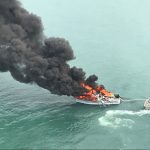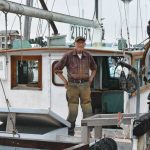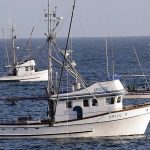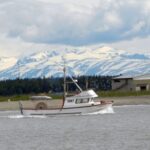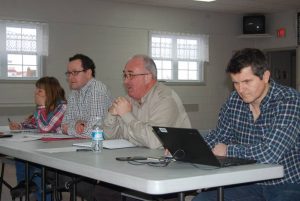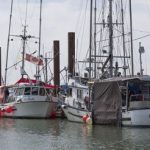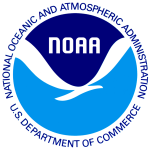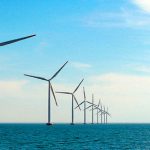Tag Archives: Dungeness crab
Washington Department of Fish and Wildlife – Crab still soft, light on meat
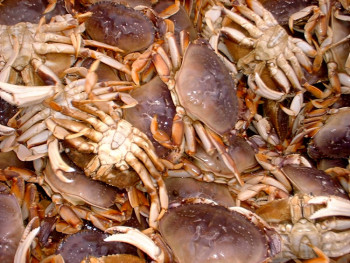 Dungeness crab in the Long Beach area are putting on meat at a slower rate than last year, possibly calling into question whether they will be ready for harvest by the traditional Dec. 1 start date. Samples gathered by Oct. 24 in the Long Beach test area had a meat-recovery rate of 19.9 percent, compared to 23 percent from samples gathered by Oct. 30 last year. Samples from the Westport area collected on or before Oct. 27 had a recovery rate of 20.2 percent, compared to 22.9 percent last year. A test conducted by the Quinault Indian Nation (off Westport and Point Grenville) on Oct. 17 had a pick-out rate of 16.5 percent, according to an Oct. 31 report by the Washington Department of Fish and Wildlife. click here to read the story 19:37
Dungeness crab in the Long Beach area are putting on meat at a slower rate than last year, possibly calling into question whether they will be ready for harvest by the traditional Dec. 1 start date. Samples gathered by Oct. 24 in the Long Beach test area had a meat-recovery rate of 19.9 percent, compared to 23 percent from samples gathered by Oct. 30 last year. Samples from the Westport area collected on or before Oct. 27 had a recovery rate of 20.2 percent, compared to 22.9 percent last year. A test conducted by the Quinault Indian Nation (off Westport and Point Grenville) on Oct. 17 had a pick-out rate of 16.5 percent, according to an Oct. 31 report by the Washington Department of Fish and Wildlife. click here to read the story 19:37

Fishermen: ‘We want to be proactive’ – Making The Sea Safer For Whales
More than 30 times this year, the federal government has received reports of whales tangled in fishing gear along the West Coast. Sometimes the whales manage to wriggle free. Other times you see heart-rending pictures on the news or a rescue mission. The culprit often involves Dungeness crab pot lines. Now Oregon crabbers are working with marine scientists to make the seas safer for whales and to avoid a black mark on their brand. Bob Eder has fished commercially out of Newport, Oregon for decades. “Over 45 years of pulling crab pots—I think I’ve probably hauled in close to a million—I’ve never encountered an entangled whale,” he said. ‘We want to be proactive’ click here to read the story 09:03
Dungeness crab season could be delayed again by the toxin domoic acid
 Dungeness crab season is approaching in the Bay Area, along with all the rituals that come with it — the crab feeds and holiday dinners piled with crab legs, sourdough bread and crocks of melted butter. Unfortunately, there’s another, more recent local tradition that is also back: uncertainty about whether algal blooms will delay the season. Domoic acid is the naturally occurring toxin caused by algal blooms that delayed the past two Dungeness crab seasons. According to test results from the California Department of Public Health, elevated levels of the toxin have shown up in samples of Dungeness crab collected in recent weeks at several North Coast ports. However, the agency said it’s too soon to say whether domoic acid will delay the commercial Dungeness fishery, due to open Nov. 15. click here to read the story 11:05
Dungeness crab season is approaching in the Bay Area, along with all the rituals that come with it — the crab feeds and holiday dinners piled with crab legs, sourdough bread and crocks of melted butter. Unfortunately, there’s another, more recent local tradition that is also back: uncertainty about whether algal blooms will delay the season. Domoic acid is the naturally occurring toxin caused by algal blooms that delayed the past two Dungeness crab seasons. According to test results from the California Department of Public Health, elevated levels of the toxin have shown up in samples of Dungeness crab collected in recent weeks at several North Coast ports. However, the agency said it’s too soon to say whether domoic acid will delay the commercial Dungeness fishery, due to open Nov. 15. click here to read the story 11:05
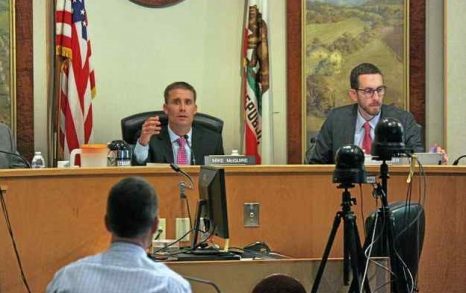
‘Time is of the essence’: California Fisheries face uncertainty
State regulators and fishing officials said at a Eureka hearing on Friday that only by working together can they overcome the trials and uncertainty that several California’s fisheries face today. With a poor salmon catch in 2017 and 2016 and a potential delay in the North Coast Dungeness crab season following three years of poor landings and abnormal ocean conditions, Pacific Coast Federation of Fishermen’s Associations Executive Director Noah Oppenheim said fishing fleets are still feeling the economic effects and that time to address the underlying issues is running slim. click here to read the story 08:46
Southeast summer Dungeness harvest the worst in decades
 The summer season for Dungies closed three weeks early in Southeast. I sat down with Kellii Wood, a Crab Biologist with the Alaska Department of Fish and Game, to ask what happened. “How did it go this year,” I ask her. Wood laughs and gives a drawn out, “well.” The thing is Dungeness crab in Southeast are tricky because state managers don’t know a lot about them. The crab are on a four to five year life cycle and the commercial fishery is expected to fluctuate accordingly. But there are no stock assessment surveys so biologists rely on commercial harvests to track the population.,,, Wood says there has been some anecdotal evidence from fishermen reporting light-colored crab near the end of the fishery. That would indicate crab that recently molted. So this summer’s low harvest could be due to a late molt. It could mean that the crab are there, it’s just bad timing. Audio, click hereto read the story 12:36
The summer season for Dungies closed three weeks early in Southeast. I sat down with Kellii Wood, a Crab Biologist with the Alaska Department of Fish and Game, to ask what happened. “How did it go this year,” I ask her. Wood laughs and gives a drawn out, “well.” The thing is Dungeness crab in Southeast are tricky because state managers don’t know a lot about them. The crab are on a four to five year life cycle and the commercial fishery is expected to fluctuate accordingly. But there are no stock assessment surveys so biologists rely on commercial harvests to track the population.,,, Wood says there has been some anecdotal evidence from fishermen reporting light-colored crab near the end of the fishery. That would indicate crab that recently molted. So this summer’s low harvest could be due to a late molt. It could mean that the crab are there, it’s just bad timing. Audio, click hereto read the story 12:36
Crab bill strengthening the Pacific Northwest’s Dungeness crab industry heads to President Trump
 A bill introduced by Oregon’s Sens. Ron Wyden and Jeff Merkley to strengthen Oregon’s crab fishery passed the United States Senate and will now head to the president’s desk for signature into law. The bill permanently extends a decades-long fishery management agreement that has been vital to the Pacific Northwest’s Dungeness crab fishery.,,, The states of Oregon, Washington, and California cooperatively manage the West Coast crab fishery in federal waters under a tri-state agreement that Congress first authorized in 1998. The act would make that authority permanent. click here to read the story 15:51
A bill introduced by Oregon’s Sens. Ron Wyden and Jeff Merkley to strengthen Oregon’s crab fishery passed the United States Senate and will now head to the president’s desk for signature into law. The bill permanently extends a decades-long fishery management agreement that has been vital to the Pacific Northwest’s Dungeness crab fishery.,,, The states of Oregon, Washington, and California cooperatively manage the West Coast crab fishery in federal waters under a tri-state agreement that Congress first authorized in 1998. The act would make that authority permanent. click here to read the story 15:51
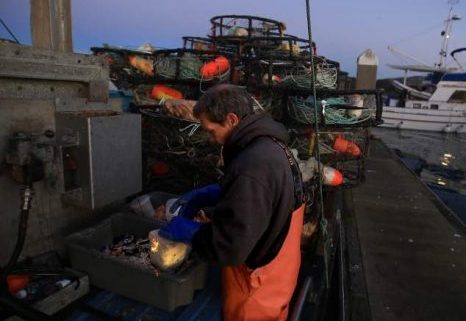
California Dungeness crab fleet nets $68 million haul, but small boats continue to struggle
California’s valuable Dungeness crab fishery appears to have rebounded after a disastrous 2015-16 season that threatened to knock even longtime fishermen so far back on their heels some feared they might not recover. Preliminary figures from the 2016-17 season show statewide commercial landings at more than $68.2 million, above the most recent 10-year average, and bested only twice in that period, including the peak $95.5 million haul in 2011-12.,,, But the relative bounty of the season, many said, obscures continued hardship for small, family operations disadvantaged by management shifts in the commercial crabbing season. But the results of those and continued serial openings onward up the coast meant that the biggest boats — those which can move their gear in one go and fill a large hold with crabs before having to return to shore — could converge on each small area that opened, whatever the weather or water conditions. The staggered openings meant big boats cleaned up and the small boats were left behind. click here to read the story 11:47
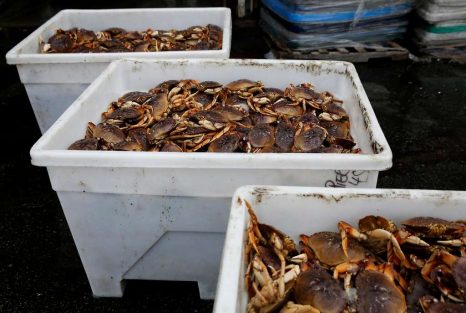
California Dungeness crab industry bounces back with strong season
Crabbers, seafood processors and state biologists agree that the most recent Dungeness crab season, which ended June 30 south of Mendocino County, was above average. Considering the disastrous previous season of 2015-16, which featured historic, months-long closures in the Dungeness crab fishery due to the presence of domoic acid in the animals, that’s more than above-average news. “We made some money,” said Shane Lucas, who fishes for crab out of Bodega Bay, where he also owns the Fishetarian Fish Market. Based on preliminary data, the 2016-17 season brought in over 21 million pounds of Dungeness crab to California ports, worth $66.7 million.,,, But this year’s crab season was not without its issues. click here to read the story 16:33
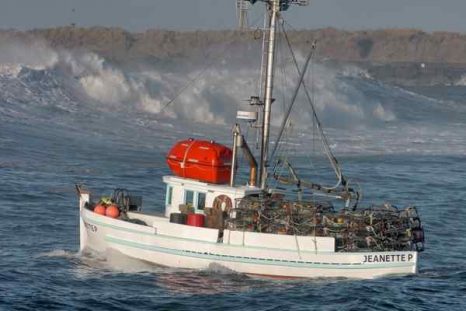
With no relief funds in sight, crab fishermen discuss next steps
After four years of poor crab and salmon fishing, including one of the worst crab seasons in recent memory, local fisherman and Eureka resident Bob Borck decided in November that it was time to move on. After selling his fishing vessel — the Belle J II — of four years in January, Borck is now planning to start work as a contractor. “I couldn’t be married to the boat,” he said Friday. “I’ve got enough family responsibilities on shore that it was too difficult to dedicate it to everything it needed to be.” Borck said he isn’t walking away from the industry completely if the right opportunity presents itself. But he said isn’t pining to return to it either, especially following a “pretty hard financial beating” after toxic algae blooms closed the 2015-16 Dungeness crab season for six months, placing many fishermen into debt. Borck’s story is not unique. Click here to read the story 08:01
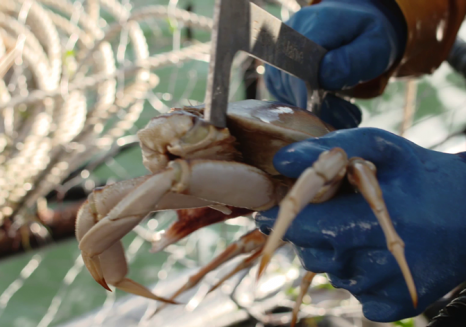
In Seaside, Oregon, youngsters are learning about crabs in ‘Boat to School’
Commercial Dungeness crab season is red-hot and rolling despite cold and wet conditions. Dean Ellsworth says his 44-foot fishing boat, the “Nola K,” is his winter home at this time of year. Ellsworth and his three-man crew spend long days and nights tossing out and pulling in nearly a thousand 80-pound crab pots during a fishing season that’s hitting its stride.,, This year, fishermen say Oregon seafood is so important to the state that it’s time to take the message to school. In Seaside, Oregon youngsters are learning valuable lessons about Oregon’s famous seafood. The program is called “Boat to School,” and it’s a pilot project that brings together educators, their students and fishermen who show and tell the fifth graders at Seaside’s Heights Elementary School where their food comes from. Photo gallery, read the story here 08:47
Crabbing: an inherently dangerous job
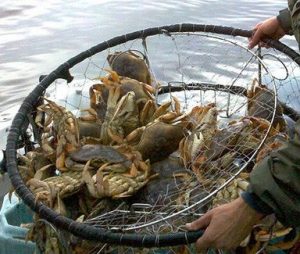 Some may wonder if the 2017 Dungeness crab season was ill-fated: First delayed by weeks to make certain crab were free of domoic acid toxin, delayed again after processors proposed lowering the price paid to crabbers, and then it started with a capsizing near the mouth of the Columbia River that could have cost five lives except for quick intervention by another crabbing boat. Today’s crabbers and fishermen have to be smart and rational to survive — literally and economically. Delays in the season also often have strategic components involving jockeying over price, and competition over crabbing grounds. Sometimes crabbers wait to allow an early-season storm to pass. Read the op-ed here 18:59
Some may wonder if the 2017 Dungeness crab season was ill-fated: First delayed by weeks to make certain crab were free of domoic acid toxin, delayed again after processors proposed lowering the price paid to crabbers, and then it started with a capsizing near the mouth of the Columbia River that could have cost five lives except for quick intervention by another crabbing boat. Today’s crabbers and fishermen have to be smart and rational to survive — literally and economically. Delays in the season also often have strategic components involving jockeying over price, and competition over crabbing grounds. Sometimes crabbers wait to allow an early-season storm to pass. Read the op-ed here 18:59
Today’s Dungeness crab fisherman must be smart, rational to survive
 Some may wonder if the 2017 Dungeness crab season is ill-fated: First delayed by weeks to make certain crab were free of domoic acid toxin, delayed again after processors proposed lowering the price paid to crabbers, and then it started with a capsizing that could have cost five lives except for quick intervention by the Ballad. Today’s crabbers and fishermen have to be smart and rational to survive — literally and economically. Crab around the mouth of the Columbia this season never exceeded safe levels of marine toxin, but the industry is united in striving to preserve the reputation of Dungeness crab as a pure, premium product. For this reason alone, it’s sensible to take every precaution. Delays in the season also often have strategic components involving jockeying over price, and competition over crabbing grounds. Sometimes crabbers wait to allow an early-season storm to pass. In this instance, the closure went longer than most anyone wanted. Read the op-ed here 10:41
Some may wonder if the 2017 Dungeness crab season is ill-fated: First delayed by weeks to make certain crab were free of domoic acid toxin, delayed again after processors proposed lowering the price paid to crabbers, and then it started with a capsizing that could have cost five lives except for quick intervention by the Ballad. Today’s crabbers and fishermen have to be smart and rational to survive — literally and economically. Crab around the mouth of the Columbia this season never exceeded safe levels of marine toxin, but the industry is united in striving to preserve the reputation of Dungeness crab as a pure, premium product. For this reason alone, it’s sensible to take every precaution. Delays in the season also often have strategic components involving jockeying over price, and competition over crabbing grounds. Sometimes crabbers wait to allow an early-season storm to pass. In this instance, the closure went longer than most anyone wanted. Read the op-ed here 10:41
Pacific Choice play for pocket change threatens to sink a second crab season – End crab strike: Pay the full $3
 North Coast commercial crabbers had a bad enough time last season, thanks to domoic acid spikes. But at least they could blame that on algae blooms and health concerns. This season could be undone by something entirely within human control: The unwillingness of seafood company Pacific Choice to shell out 25 cents more per pound for Dungeness crab meat. Crab prices have been set at $3 per pound since the November opening of the season; Pacific Choice wants to pay 25 cents less. The price dispute has put another crab season on hold. Local crab boats, if they stooped to selling crab for $2.75 per pound, would lose between $7,000 to $10,000 per average medium to small boat, according to the Humboldt Fishermen’s Marketing Association. Read the op-ed here 07:50
North Coast commercial crabbers had a bad enough time last season, thanks to domoic acid spikes. But at least they could blame that on algae blooms and health concerns. This season could be undone by something entirely within human control: The unwillingness of seafood company Pacific Choice to shell out 25 cents more per pound for Dungeness crab meat. Crab prices have been set at $3 per pound since the November opening of the season; Pacific Choice wants to pay 25 cents less. The price dispute has put another crab season on hold. Local crab boats, if they stooped to selling crab for $2.75 per pound, would lose between $7,000 to $10,000 per average medium to small boat, according to the Humboldt Fishermen’s Marketing Association. Read the op-ed here 07:50
Crab fishermen strike for higher price per-pound from Bodega Bay north through Oregon and Washington
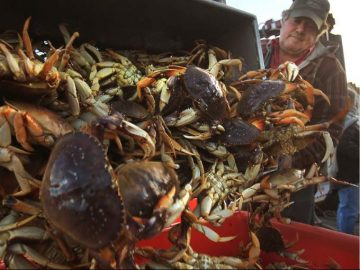 Crabbers from Bodega Bay north through Oregon and Washington to the Canadian border went on strike Wednesday afternoon after wholesale Dungeness crab buyers sought to lower the per-pound price fishermen earn for the much sought-after crustacean. Fishermen have agreed to either cease crabbing in areas off the Sonoma Coast where the Dungeness crab season has already opened, or delay the start of their season in hopes of retaining the $3-per-pound price they have earned fishing in Northern California’s rich waters so far this year, according to Lorne Edwards, president of the Bodega Bay Fisherman’s Marketing Association, an industry trade group. Read the rest of the story here 07:48
Crabbers from Bodega Bay north through Oregon and Washington to the Canadian border went on strike Wednesday afternoon after wholesale Dungeness crab buyers sought to lower the per-pound price fishermen earn for the much sought-after crustacean. Fishermen have agreed to either cease crabbing in areas off the Sonoma Coast where the Dungeness crab season has already opened, or delay the start of their season in hopes of retaining the $3-per-pound price they have earned fishing in Northern California’s rich waters so far this year, according to Lorne Edwards, president of the Bodega Bay Fisherman’s Marketing Association, an industry trade group. Read the rest of the story here 07:48
More of Commercial Dungeness Crab Fishery to Open from Point Arena to Ten Mile; One Area Still Closed
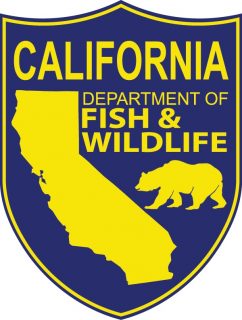 On Dec. 29, more of the California coastline will open to the commercial Dungeness crab fishery. Some previously closed areas will open at the recommendation of state health agencies, the California Department of Fish and Wildlife (CDFW) announced today. The area between Point Arena and Ten Mile River in Mendocino County will open on Dec. 29. However, due to persisting conditions of elevated domoic acid levels, the fishery will remain closed between Ten Mile River and Shelter Cove. The closed portions of the coast may open once testing by state agencies shows that domoic acid in crabs from the area no longer poses a significant risk to public health. On Dec. 29 at 12:01 a.m., the commercial Dungeness crab season will open from 38° 57.5′ N. Lat. (near Point Arena) to 39° 33.3′ N. Lat. (near Ten Mile River).The opener in this area will be preceded by a 64-hour pre-soak period commencing at 8 a.m. on Dec. 26. The area between Ten Mile River and Shelter Cove will remain closed until,,, Read the press release here 17:46
On Dec. 29, more of the California coastline will open to the commercial Dungeness crab fishery. Some previously closed areas will open at the recommendation of state health agencies, the California Department of Fish and Wildlife (CDFW) announced today. The area between Point Arena and Ten Mile River in Mendocino County will open on Dec. 29. However, due to persisting conditions of elevated domoic acid levels, the fishery will remain closed between Ten Mile River and Shelter Cove. The closed portions of the coast may open once testing by state agencies shows that domoic acid in crabs from the area no longer poses a significant risk to public health. On Dec. 29 at 12:01 a.m., the commercial Dungeness crab season will open from 38° 57.5′ N. Lat. (near Point Arena) to 39° 33.3′ N. Lat. (near Ten Mile River).The opener in this area will be preceded by a 64-hour pre-soak period commencing at 8 a.m. on Dec. 26. The area between Ten Mile River and Shelter Cove will remain closed until,,, Read the press release here 17:46
Southeast Alaska Dungeness fall harvest was lower than expected
 The fall harvest was approximately 403,000 pounds. That’s about 150,000 pounds less than last year. Kellii Wood is a Crab Biologist with the Alaska Department of Fish and Game. She says they’ve seen harvests like this before but it’s been a while. “It’s definitely down from previous years,” Wood says. “We have been lower but I believe it was in the 90s.” Wood says the harvest is far below the five year fall average of 732,000 pounds. About one-fifth of the year’s harvest comes in the fall. This year was just a little below that. Wood says the recent average is a bit skewed when you consider 2014. It was an unusually good year seeing the third highest fall harvest on record since the 1960s. That fall fishermen harvested about a million pounds. Listen to the audio report here 13:55
The fall harvest was approximately 403,000 pounds. That’s about 150,000 pounds less than last year. Kellii Wood is a Crab Biologist with the Alaska Department of Fish and Game. She says they’ve seen harvests like this before but it’s been a while. “It’s definitely down from previous years,” Wood says. “We have been lower but I believe it was in the 90s.” Wood says the harvest is far below the five year fall average of 732,000 pounds. About one-fifth of the year’s harvest comes in the fall. This year was just a little below that. Wood says the recent average is a bit skewed when you consider 2014. It was an unusually good year seeing the third highest fall harvest on record since the 1960s. That fall fishermen harvested about a million pounds. Listen to the audio report here 13:55
Crescent City Harbor – Plump crab off the F/V Dynamik
 The frenzy may have died down at the Crescent City Harbor, but Derrick Horn and other dock workers for Caito Fisheries were still pulling Dungeness crab from their boats on Tuesday. Horn and his crew unloaded 72,000 pounds of claw clacking crustaceans off the F/V Dynamik of Brookings, the largest boat in Caito’s Crescent City fleet. The vessels the seafood buyer uses are still staying full and the crab are excellent, Horn said. “They’re better than average from the last four years,” he said of the catch so far. “I just measured one I thought was small and it was (still) good size.” Two weeks after the season opened on Dec. 1, activity on Citizen’s Dock appears to have dropped off. Smaller boats are coming in with lighter loads, according to Horn. And Crescent City Harbormaster CEO Charlie Helms notes there are fewer refrigerated trucks waiting to be loaded. But crabbers are still plying their trade in Del Norte waters and getting $3 per pound, Helms said. “They’re still catching,”,,, Read the story here 12:43
The frenzy may have died down at the Crescent City Harbor, but Derrick Horn and other dock workers for Caito Fisheries were still pulling Dungeness crab from their boats on Tuesday. Horn and his crew unloaded 72,000 pounds of claw clacking crustaceans off the F/V Dynamik of Brookings, the largest boat in Caito’s Crescent City fleet. The vessels the seafood buyer uses are still staying full and the crab are excellent, Horn said. “They’re better than average from the last four years,” he said of the catch so far. “I just measured one I thought was small and it was (still) good size.” Two weeks after the season opened on Dec. 1, activity on Citizen’s Dock appears to have dropped off. Smaller boats are coming in with lighter loads, according to Horn. And Crescent City Harbormaster CEO Charlie Helms notes there are fewer refrigerated trucks waiting to be loaded. But crabbers are still plying their trade in Del Norte waters and getting $3 per pound, Helms said. “They’re still catching,”,,, Read the story here 12:43
State of Oregon opens portion of coast for commercial Dungeness crabbing
 The Oregon Department of Fish and Wildlife and the Oregon Department of Agriculture have announced that the opening of the commercial crab season from Cape Blanco to the Oregon/California border is set for Dec. 18.“We have consistently taken a very precautionary approach when opening our crab fisheries,” said ODFW Marine Resources Program Manager Caren Braby. “Recent test results have consistently shown low biotoxin results on the southern end of the state and decreasing levels in ports north of this area indicating they are of excellent quality, safe for consumption and ready for harvest.” In addition, the Oregon Dungeness Crab Commission announced Tuesday that Oregon Dungeness crab fishermen and seafood processor representatives participating in state-supervised crab price negotiations have agreed on an opening price of $3 per pound for the 2017 Dungeness crab season partial opening this week. Read the rest of the story here 08:59
The Oregon Department of Fish and Wildlife and the Oregon Department of Agriculture have announced that the opening of the commercial crab season from Cape Blanco to the Oregon/California border is set for Dec. 18.“We have consistently taken a very precautionary approach when opening our crab fisheries,” said ODFW Marine Resources Program Manager Caren Braby. “Recent test results have consistently shown low biotoxin results on the southern end of the state and decreasing levels in ports north of this area indicating they are of excellent quality, safe for consumption and ready for harvest.” In addition, the Oregon Dungeness Crab Commission announced Tuesday that Oregon Dungeness crab fishermen and seafood processor representatives participating in state-supervised crab price negotiations have agreed on an opening price of $3 per pound for the 2017 Dungeness crab season partial opening this week. Read the rest of the story here 08:59
Santa Cruz crabbers face a slow start to the season
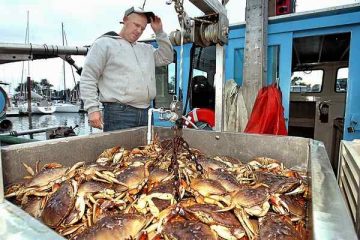 Three weeks into commercial crab season, Santa Cruz harbor fishermen are having a tough time finding crabs. “The season in Santa Cruz has been pretty slow,” said Hans Haveman of H&H Fresh Fish, a wholesale and retail fish seller at the harbor. “There’s crabs coming in, but not nearly in the numbers we would like or that we’d seen in the past few years.” The harbor has 15 to 20 active commercial crab boats that fish for the wildly popular Dungeness crab along with the less famous rock and spider crab, according to the Santa Cruz harbormaster. Three weeks into the season last year, each boat was bringing in an average of 800 to 1,000 pounds of crab a day, but this year that number has plummeted to about 100 to 200 pounds a day. “We don’t really know what’s going on,” Haveman said, who buys crabs from nine boats. Read the story here 11:13
Three weeks into commercial crab season, Santa Cruz harbor fishermen are having a tough time finding crabs. “The season in Santa Cruz has been pretty slow,” said Hans Haveman of H&H Fresh Fish, a wholesale and retail fish seller at the harbor. “There’s crabs coming in, but not nearly in the numbers we would like or that we’d seen in the past few years.” The harbor has 15 to 20 active commercial crab boats that fish for the wildly popular Dungeness crab along with the less famous rock and spider crab, according to the Santa Cruz harbormaster. Three weeks into the season last year, each boat was bringing in an average of 800 to 1,000 pounds of crab a day, but this year that number has plummeted to about 100 to 200 pounds a day. “We don’t really know what’s going on,” Haveman said, who buys crabs from nine boats. Read the story here 11:13
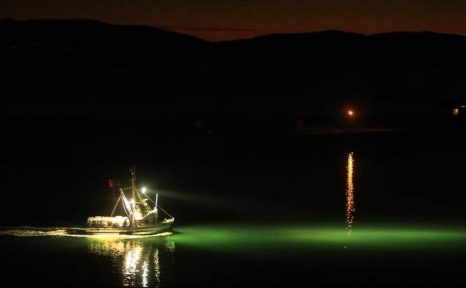
Bodega Bay boats set out for Dungeness crab along Sonoma Coast
The full force and focus of the West Coast crabbing fleet has turned on the waters off Sonoma County, where newly opened fishing grounds are expected to yield the next crop of holiday Dungeness crab. Local fishing vessels left docks in droves before dawn Friday to start setting traps in a fishery whose bounty has made the sweet, succulent crustaceans an important cash crop around the North Coast. Boats from around California, as well as Oregon and Washington, where the crab seasons have been delayed, have also joined in the latest opening, making for crowded, derby-style action that gives the advantage to the very biggest boats, crabbers say. “I’ve never seen this many boats and this much gear north of Point Reyes,” Windsor crabber Ben Platt said by phone Friday off the Sonoma Coast as he deployed traps earlier set in Half Moon Bay, where he started the season. 11 great images, read the story here 08:30
Sonoma Coast Dungeness crab season delayed
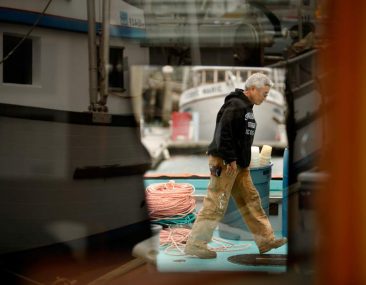 Thousands of crab traps, stacked six feet or higher, line the sides of Westshore Road surrounding the Spud Point Marina, a clear indication this year’s commercial Dungeness crab season along the North Coast is off to another rocky start. “Look at what’s happening at Spud Point — there’s probably 10,000 pots sitting out there. Those are guys who aren’t going out,” said Charlie Beck, a Bodega Bay fisherman who has been crabbing in the waters off the Sonoma Coast nearly 40 years. “Our small fishing fleet is getting destroyed. Last year was the worst season that we’ve ever seen, and this year it’s looking pretty bleak, especially for the smaller boats.” State health officials last week recommended an indefinite delay for Dungeness along a 180-mile stretch of coastal waters along Northern California, from Point Reyes in Marin County to Humboldt Bay in Mendocino County, dealing another blow to the North Coast’s lucrative wintertime crabbing season following last year’s 4½-month delay. Read the story here with 12 images 10:01
Thousands of crab traps, stacked six feet or higher, line the sides of Westshore Road surrounding the Spud Point Marina, a clear indication this year’s commercial Dungeness crab season along the North Coast is off to another rocky start. “Look at what’s happening at Spud Point — there’s probably 10,000 pots sitting out there. Those are guys who aren’t going out,” said Charlie Beck, a Bodega Bay fisherman who has been crabbing in the waters off the Sonoma Coast nearly 40 years. “Our small fishing fleet is getting destroyed. Last year was the worst season that we’ve ever seen, and this year it’s looking pretty bleak, especially for the smaller boats.” State health officials last week recommended an indefinite delay for Dungeness along a 180-mile stretch of coastal waters along Northern California, from Point Reyes in Marin County to Humboldt Bay in Mendocino County, dealing another blow to the North Coast’s lucrative wintertime crabbing season following last year’s 4½-month delay. Read the story here with 12 images 10:01
Local crab hauls set to hit ports on Thursday; buying price set at $3 per pound
 The following is a press release issued by the Humboldt Fishermen’s Marketing Association: fishermen in District 6 (North Jetty Humboldt Bay to Oregon Border) can begin setting crab pots today, but many local fishermen may stay tied up. Rough ocean conditions and a very large northwesterly swell forecast by the National Weather Service is expected to produce unsafe conditions on the ocean and Humboldt Bay Bar. Meanwhile, boats out of Trinidad and Crescent City will also begin setting pots. Dungeness crabs in District 6 have tested free of domoic acid (a naturally occurring compound) and are reported to be of exceptional quality with high meat recovery. District 6 is the only area north of Point Reyes, San Francisco open to crab fishing in California. Oregon could open as soon as December 15, and Washington State sometime later. Because of limited fishing area and high crab quality, the three local fishermen’s associations (Humboldt, Trinidad, and Crescent City) discussed the possibility of waiting to begin fishing in order to negotiate with crab buyers for a higher price. Unable to achieve consensus on the issue of price, the crab fleet will start fishing with an ex-vessel price of $3 per pound. The first local crabs of the season will be delivered to our ports on December 1st. Link 14:33
The following is a press release issued by the Humboldt Fishermen’s Marketing Association: fishermen in District 6 (North Jetty Humboldt Bay to Oregon Border) can begin setting crab pots today, but many local fishermen may stay tied up. Rough ocean conditions and a very large northwesterly swell forecast by the National Weather Service is expected to produce unsafe conditions on the ocean and Humboldt Bay Bar. Meanwhile, boats out of Trinidad and Crescent City will also begin setting pots. Dungeness crabs in District 6 have tested free of domoic acid (a naturally occurring compound) and are reported to be of exceptional quality with high meat recovery. District 6 is the only area north of Point Reyes, San Francisco open to crab fishing in California. Oregon could open as soon as December 15, and Washington State sometime later. Because of limited fishing area and high crab quality, the three local fishermen’s associations (Humboldt, Trinidad, and Crescent City) discussed the possibility of waiting to begin fishing in order to negotiate with crab buyers for a higher price. Unable to achieve consensus on the issue of price, the crab fleet will start fishing with an ex-vessel price of $3 per pound. The first local crabs of the season will be delivered to our ports on December 1st. Link 14:33
Crab season in full gear: Commercial season off to good start at Pillar Point Harbor
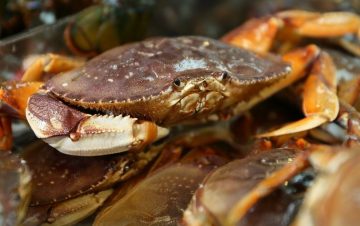 One week after the long-anticipated commercial Dungeness crab season roared to life, hundreds of fishermen and crustacean-craving customers are eagerly indulging in the multi-million dollar industry. State wildlife officials gave the thumbs up for commercial fishermen to begin reeling in crab pots Nov. 15, just in time to satiate a Thanksgiving market. A rainy opening weekend was initially feared to keep customers who buy directly off the boat at bay. Fortunately, gray skies were not a deterrent to those who’ve waited more than a year for fresh crab, said commercial fisherman Barry Day, who reflected on the first weekend of the season. “The leadup to it, I was sitting in the coffee shop thinking, ‘aw, they’re still all scared and there might be a couple of people.’ But I came up here and I fell off my god damn chair. It was raining and we still got bombed. People, people, people! And I’m so grateful for that. I thought wow, the people are back. It’s fantastic,” Day said. “Even in the rain, we were all dripping and wow, totally awesome.” Read the story here 08:10
One week after the long-anticipated commercial Dungeness crab season roared to life, hundreds of fishermen and crustacean-craving customers are eagerly indulging in the multi-million dollar industry. State wildlife officials gave the thumbs up for commercial fishermen to begin reeling in crab pots Nov. 15, just in time to satiate a Thanksgiving market. A rainy opening weekend was initially feared to keep customers who buy directly off the boat at bay. Fortunately, gray skies were not a deterrent to those who’ve waited more than a year for fresh crab, said commercial fisherman Barry Day, who reflected on the first weekend of the season. “The leadup to it, I was sitting in the coffee shop thinking, ‘aw, they’re still all scared and there might be a couple of people.’ But I came up here and I fell off my god damn chair. It was raining and we still got bombed. People, people, people! And I’m so grateful for that. I thought wow, the people are back. It’s fantastic,” Day said. “Even in the rain, we were all dripping and wow, totally awesome.” Read the story here 08:10
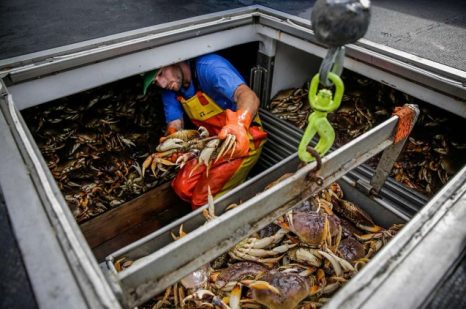
Commercial Dungeness crab season under way in the Bay Area
After a fair amount of nail-biting about whether the season would open on time, commercial fishers brought their first haul of Dungeness crab to Bay Area docks Tuesday afternoon. The shellfish should arrive in restaurants as early as Wednesday and in fish markets later this week, meaning Bay Area families can return to the tradition of celebrating Thanksgiving with platters of freshly steamed and cracked Dungeness crab. Fishers and processors negotiated a price of $3 per pound to fishers, on top of which processors add delivery and labor costs. Crab boats began dropping their pots in the ocean Monday and were allowed to start pulling them up at 12:01 a.m. Tuesday. “There’s some pretty good quality,” said Nick Gunnarsson, a deckhand on the New Rayann, while unloading 8,000 pounds of fresh crab on Pier 45. Read the rest here 09:24
Commercial Dungeness crab season to open throughout most of the Southern Fishery; one area will remain closed
On Tuesday, Nov. 15, commercial Dungeness crab season will open from Point Reyes in Marin County south, the  (CDFW) announced. But at the recommendation of state health agencies, the CDFW Director is moving to close the commercial Dungeness crab fishery between Point Reyes and the Sonoma/Mendocino County line and to close the commercial rock crab fishery north of Pigeon Point in San Mateo County. This has the effect of closing approximately 60 miles of coastline to commercial Dungeness crab fishing that otherwise would have opened on Nov. 15. The fishery north of the Sonoma/Mendocino county line is not scheduled to open until Dec. 1. The commercial Dungeness crab fishery had been scheduled to open all the way up to the Sonoma/Mendocino county line (about 60 miles north of Point Reyes) on Nov. 15 and the rock crab fishery is otherwise open year round, but some crabs collected and tested showed elevated levels of domoic acid. The naturally occurring toxin can sicken people who consume crab. Read the rest here 08:08
(CDFW) announced. But at the recommendation of state health agencies, the CDFW Director is moving to close the commercial Dungeness crab fishery between Point Reyes and the Sonoma/Mendocino County line and to close the commercial rock crab fishery north of Pigeon Point in San Mateo County. This has the effect of closing approximately 60 miles of coastline to commercial Dungeness crab fishing that otherwise would have opened on Nov. 15. The fishery north of the Sonoma/Mendocino county line is not scheduled to open until Dec. 1. The commercial Dungeness crab fishery had been scheduled to open all the way up to the Sonoma/Mendocino county line (about 60 miles north of Point Reyes) on Nov. 15 and the rock crab fishery is otherwise open year round, but some crabs collected and tested showed elevated levels of domoic acid. The naturally occurring toxin can sicken people who consume crab. Read the rest here 08:08
Bright outlook for Dungeness crab season and holiday feasts
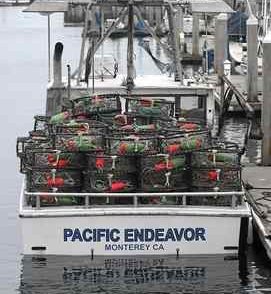 After enduring the most dismal Dungeness crab season in memory, one that ravaged fishermen and left consumers with the holiday blues, Bay Area crab lovers can put on their party hats. The 2016-17 commercial crab season will begin Tuesday on schedule, state regulators declared this week. The harmful algae blooms that tainted last year’s catch with a neurotoxin known as domoic acid have receded to normal levels along most of the California coast. That means Bay Area consumers will in all likelihood have crab for the Thanksgiving and Christmas holidays, and fishermen will begin to recover from a brutal 18-month period in which a delayed and abbreviated crab season was sandwiched between two poor Chinook salmon seasons. “We’re just excited to get back out there,” said Devin Bunch, Read the story here 13:43
After enduring the most dismal Dungeness crab season in memory, one that ravaged fishermen and left consumers with the holiday blues, Bay Area crab lovers can put on their party hats. The 2016-17 commercial crab season will begin Tuesday on schedule, state regulators declared this week. The harmful algae blooms that tainted last year’s catch with a neurotoxin known as domoic acid have receded to normal levels along most of the California coast. That means Bay Area consumers will in all likelihood have crab for the Thanksgiving and Christmas holidays, and fishermen will begin to recover from a brutal 18-month period in which a delayed and abbreviated crab season was sandwiched between two poor Chinook salmon seasons. “We’re just excited to get back out there,” said Devin Bunch, Read the story here 13:43
Poor Ocean Conditions Hit West Coast Fisheries Hard
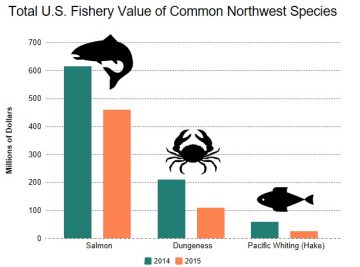 United States commercial fisheries are doing fine overall, but fishermen on the West Coast are hurting. An 2015 annual report out Wednesday from the National Oceanic and Atmospheric Administration shows a stark fall-off in the big seafood money-makers in the Pacific Northwest. Nationally, 2015 was an above average year in terms of catch rate, commercial value and national seafood consumption. “On dinner plates, the average American added nearly an extra pound of seafood,” said Richard Merrick, Chief Scientists of NOAA Fisheries during a call with reporters. But this rise in consumption didn’t really help the Oregon and Washington fishing industry because the crab and fish weren’t there to catch. NOAA Fisheries scientists are attributing the low West Coast returns to abnormal conditions in the Pacific that are linked to climate change. Read the story here 19:11
United States commercial fisheries are doing fine overall, but fishermen on the West Coast are hurting. An 2015 annual report out Wednesday from the National Oceanic and Atmospheric Administration shows a stark fall-off in the big seafood money-makers in the Pacific Northwest. Nationally, 2015 was an above average year in terms of catch rate, commercial value and national seafood consumption. “On dinner plates, the average American added nearly an extra pound of seafood,” said Richard Merrick, Chief Scientists of NOAA Fisheries during a call with reporters. But this rise in consumption didn’t really help the Oregon and Washington fishing industry because the crab and fish weren’t there to catch. NOAA Fisheries scientists are attributing the low West Coast returns to abnormal conditions in the Pacific that are linked to climate change. Read the story here 19:11
State of California officials optimistic for crab season: Coast Guard to begin safety inspections
 The upcoming Dungeness crab season appears to be headed in a good direction and authorities are reminding fishermen to begin checking their safety equipment in preparation for the season, according to the state’s Department of Fish and Wildlife and the U.S. Coast Guard. Coast Guard officials are set to being inspecting crab-fishing vessels next month on Nov. 8, 9 and 10 at commercial fishing ports from Monterey to Crescent City. The safety checks are part of the Coast Guard’s Operation Safe Crab, an outreach initiative intended to reduce fatalities and accidents during the season. During the safety checks, Coast Guard personnel check vessels for the required lifesaving equipment, pot-loading practices affecting stability and vessel watertight integrity, according to the Coast Guard. Commercial crab fishing is an inherently dangerous job and West Coast crabbing vessels reportedly have a high fatality rate, Coast Guard officials said. Read the story here 08:32
The upcoming Dungeness crab season appears to be headed in a good direction and authorities are reminding fishermen to begin checking their safety equipment in preparation for the season, according to the state’s Department of Fish and Wildlife and the U.S. Coast Guard. Coast Guard officials are set to being inspecting crab-fishing vessels next month on Nov. 8, 9 and 10 at commercial fishing ports from Monterey to Crescent City. The safety checks are part of the Coast Guard’s Operation Safe Crab, an outreach initiative intended to reduce fatalities and accidents during the season. During the safety checks, Coast Guard personnel check vessels for the required lifesaving equipment, pot-loading practices affecting stability and vessel watertight integrity, according to the Coast Guard. Commercial crab fishing is an inherently dangerous job and West Coast crabbing vessels reportedly have a high fatality rate, Coast Guard officials said. Read the story here 08:32
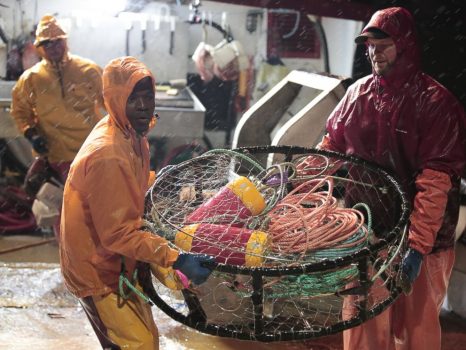
Inside One of the World’s Most Dangerous Jobs
Up to 10 inches wide -– some weighing almost 3 pounds — with 10 legs and of course, claws that can break a finger — Dungeness crab fishing is not for the faint of heart. Add to that the unforgiving weather and potentially tumultuous relationships on board the boats, the situation can become dangerous and deadly at times. No one knows that better than Captain Gary ‘the Ripper’ Ripka and his son Kenny, who own and operate two commercial fishing boats in Newport, Oregon, the Dungeness Crab Capital of the World. “It’s a pretty high-risk job, the most dangerous job in the world,” Gary Ripka told ABC News’ Chief Business, Economics and Technology Correspondent Rebecca Jarvis on a recent episode of Real Biz with Rebecca Jarvis. Video, read the rest here 16:07






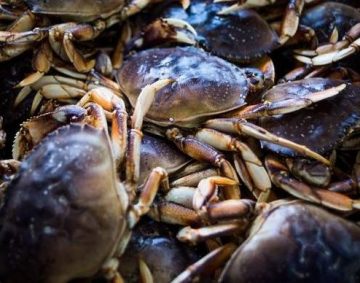 A perfect storm of weather, strong catches and domoic acid worries has led to a glut of crab on the market, overwhelming processors and making it harder for fishermen to find buyers for the high-value crustacean. Dave Hubbard, captain of the fishing vessel Katrina, said he waited 58 hours to unload 25,000 pounds of crab his crew had caught between Garibaldi and Klipsan Beach, Washington. On Monday, the Katrina docked at the Port of Astoria’s Pier 2, its catch unloaded by workers from Bornstein Seafoods. Hubbard said processors were hit by icy weather on land preventing delivery trucks and workers from coming and going. The processors have boats on catch limits, he said, based on the amount of crab pots they drop. “Everyone’s jammed up,” said Steve Fick, owner of Fishhawk Fisheries in Astoria.
A perfect storm of weather, strong catches and domoic acid worries has led to a glut of crab on the market, overwhelming processors and making it harder for fishermen to find buyers for the high-value crustacean. Dave Hubbard, captain of the fishing vessel Katrina, said he waited 58 hours to unload 25,000 pounds of crab his crew had caught between Garibaldi and Klipsan Beach, Washington. On Monday, the Katrina docked at the Port of Astoria’s Pier 2, its catch unloaded by workers from Bornstein Seafoods. Hubbard said processors were hit by icy weather on land preventing delivery trucks and workers from coming and going. The processors have boats on catch limits, he said, based on the amount of crab pots they drop. “Everyone’s jammed up,” said Steve Fick, owner of Fishhawk Fisheries in Astoria. 


























